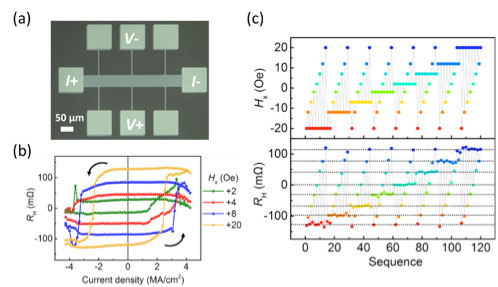| Jun 20, 2019 | |
Current-induced multilevel storage without initialization for high density magnetic memory(Nanowerk News) A team of researchers has presented an experimental characterization of a multilevel spin-orbit-torque magnetic random access memory (SOT-MRAM) cell based on a perpendicularly magnetized Ta/CoFeB/MgO heterostructure and addressed the initialization-free issue of multilevel storage schemes. |
|
| In their devices, the multilevel magnetization states and the resulted multilevel anomalous Hall effect resistances are created by changing a longitudinal domain wall pinning site in the magnet. | |
| The realization of robust intermediate switching levels in the commonly used perpendicularly magnetized Ta/CoFeB/MgO heterostructure, for conventional magnetic random access memory, provides an efficient way to switch magnets for low-power, high-endurance, and high-density memory applications. | |
| The research team is led by Long You, a professor at Nanoscale Energy Efficient Devices and Systems (NEEDS) Lab, Huazhong University of Science and Technology, Wuhan, China. This work has been published in Applied Physics Letters ("Spin-orbit-torque-driven multilevel switching in Ta/CoFeB/MgO structures without initialization"). | |
 |
|
| Multilevel states in Ta/CoFeB/MgO heterostructure controlled by eight different in-plane magnetic fields Hx under a current with a current density of J = 4.3 × 106 A cm-2. (Image: Huazhong University of Science and Technology) | |
| SOT-MRAMs, in which write and read paths are decoupled, can naturally resolve the problems related to the endurance and reliability of conventional two-terminal STT-MRAMs. | |
| However, the low storage density problem in a SOT-MRAM becomes serious owing to its three-terminal architecture. One key solution is the multilevel cell configuration, which can provide an enhanced integration density. | |
| In Ta/CoFeB/MgO heterostructures, when an in-plane charge current flows through the Ta layer, the spin current is generated due to spin Hall effect in Ta and is transmitted across the Ta/CoFeB interface. This results in application of a torque on the CoFeB layer. | |
| Moreover, the magnitude of the torque can be modulated by the applied in-plane fields, which makes it possible to drive multilevel switching with SOT in Ta/CoFeB/MgO heterostructures. | |
| “Multilevel resistance states are achieved in perpendicularly magnetized Ta/CoFeB/MgO heterostructure by controlling the magnetization configurations of the magnet through an in-plane magnetic field,” said Shuai Zhang, a coauthor in the paper. “The domain wall (DW) moves orthogonally to the current flow driven by SOT, and the final pinning position of the DW is independent of its initial state. The displacement of the DW is different if the in-plane fields changes." | |
| "Specifically" he adds, "when the in-plane field is zero, the DW finally displaces to the center of the Hall bar under the combined effect of the Oersted field, DMI field, exchange field, magnetostatic field, etc.. However, if the in-plane field is non-zero, SOT drives the DW, and moves it to a new pinning position and resulting in an intermediate magnetization between full saturation and demagnetization.” | |
| The realization of robust intermediate switching levels in the commonly used perpendicularly magnetized Ta/CoFeB/MgO heterostructure provides an efficient way to switch magnets for low-power, high-endurance, and high-density memory applications. |
| Source: Huazhong University of Science and Technology | |
|
Subscribe to a free copy of one of our daily Nanowerk Newsletter Email Digests with a compilation of all of the day's news. |
